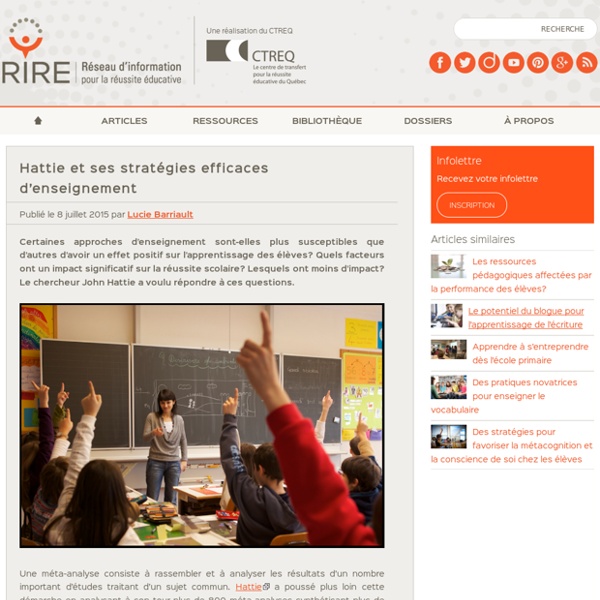



http://rire.ctreq.qc.ca/2015/07/strategies-efficaces-enseignement/
Related: marina1011 • ÉvaluationReading ability soars if young struggling readers get school’s intensive help immediately Reading skill fails to improve when schools follow current practices that require struggling readers to fail first before they merit tutoring or extra teaching Reading skills improve very little when schools follow the current standard practice of waiting for struggling readers to fail first before providing them with additional help, according to researchers at Southern Methodist University, Dallas. In contrast, a recent study found that a dynamic intervention in which struggling readers received the most intensive help immediately, enabled students to significantly outperform their peers who had to wait for additional help, said Stephanie Al Otaiba, lead author on the research. “We studied how well struggling readers respond to generally effective standard protocols of intervention to help them improve. About 40 percent of U.S. children in fourth grade do not read at a proficient level, Yovanoff said. “We’re not talking about a small group of children,” he said.
John Hattie & His High Impact Strategies Note, this article refers to John Hattie’s 2009 book, Visible Learning. You can find an updated summary of his findings here. John Hattie synthesized over 500,000+ studies related to student achievement in his book Visible Learning. In this book he showed that teachers can make a difference despite other circumstances that may impede learning. In fact, Hattie found that most teachers have some degree of impact on their students’ learning. However, some teachers have far more impact than others.
Google Drive One account. All of Google. Sign in to continue to Google Drive Need help? Forgot password? What Doesn't Work: Literacy Practices We Should Abandon The number one concern that I hear from educators is lack of time, particularly lack of instructional time with students. It's not surprising that we feel a press for time. Our expectations for students have increased dramatically, but our actual class time with students has not. Teachers As Researchers: The Power of Mindset Serena Hicks is an English and language arts teacher and professional development facilitator in West Ada School District, in Meridian, Idaho. Change is hard! In my experience, I’ve noticed that teachers are more likely to make positive changes when they get to decide when and how to change. I used to make changes in my classroom based on intuition - I just know what my students need - but found that intuition alone wasn’t enough to truly spark student learning. My gut might tell me what my students need, but there’s more to demonstrating why, for example, my 7th graders are more proficient writers when they use technology to publish their work. That quest to prove the effectiveness of my own practice started my interest in finding “research-based” teaching practices.
Google Drive One account. All of Google. Sign in to continue to Google Drive Need help? Forgot password? Demystifying Small Groups in Reading: Supporting Students in Action K-8 Written by Anna Gratz Cockerille “I think that many teachers have been subjected to intensive efforts to remake their small-group instruction so that it is 'just so.' There have been so many books written on how to lead small groups in precisely the right ways that too many teachers approach a little hub of readers, gripped by anxiety over doing this The Right Way. Reflecting on Reflection: A Habit of Mind Reflection is a fundamental tenet of learning, and therefore a fundamental part of teaching. Why it happens is a matter of humility. But how and when it happens -- and with whom -- is less clear. This is partly because there are multiple sides to reflection -- length, width, and depth. To reflect means to look back at how something "went" in all of its available parts and patterns: Causes and effects Comparisons and contrast Strengths and weakness Characteristics How close it came to expectations Your emotions.
Google Drive One account. All of Google. Sign in to continue to Google Drive Need help? Forgot password? Sign in with a different account Create account First Grade in Finland: Every Day Is a Half Day First Grade in Finland: Every Day is a Half Day When I was teaching first grade in the Greater Boston area, my Finnish wife, Johanna, loved to tell me about schools in Finland. Most of what she told me sounded mythical. According to Johanna, Finnish children started first grade at age seven. Their school days were often just four hours long. Her close Finnish friend, a first grade teacher in Helsinki, worked about 30 hours each week, including prep time.